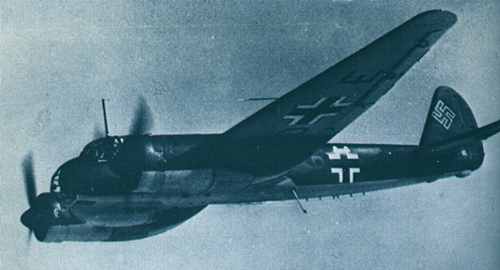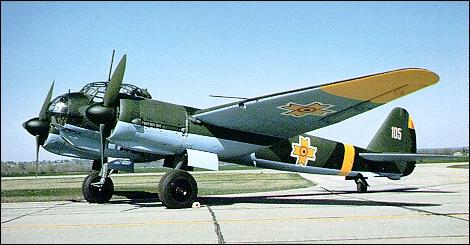|
Junkers Ju88

One of the War's most versatile aircraft,
the Junkers Ju88 was a mainstay of the German Luftwaffe throughout the
war. It was one of the very few aircraft that could roam the skies over
Britain without being vulnerable. It was tough, fast, and rather maneuverable
for a bomber. That led to a later role for the Ju88: Night-Fighter.
The Ju-88 was used in nearly every campaign, from Convoy bomber to Flying
bomb.
 |
One of the main reasons I am doing this article is because I believe
that the Ju-88 and it's counterparts have been ignored for CFS.
I would really like to see a high-quality Ju88 at Simviation. (The
other Default bombers of CFS would be nice as well!) I will not
list all the technical specifications and designations of all The
88's variants, as that is a job fit for three!
I will do an overview of the Ju88's development and operational
roles. I will then enter into it's successors, the Ju188 and Ju388.
|
| Exceeded only by the Mosquito in sheer number of forms and purposes,
the Ju88 had a long history before the war. It was first flown as
a civil prototype. The design process had been rapid. (Led by two
Americans, temporarily hired, who were well-versed in modern stressed-skin
construction.) The Ju88 never flew in a civil role, however, being
almost immediately turned into a bomber. These A-1 bombers were
heavier, and slower, but more capacious. These were just entering
service when war began. The generally good performance and formidable
bomb load were offset by wholly inadequate defensive armament. The
A-4 increased the span, and the bomb load and gun power was augmented.
This was the base on which diverse development would occur. |
 |
| The Ju88 was structurally excellent, combined large
internal capacity with a great load-carrying capacity. It was also
never degraded in performance to the point where it became vulnerable,
as were it's Dornier and Heinkel stablemates. With the BMW Radial
and the Jumo 213 engines, the later Ju88s were almost as fast as
contemporary fighters, at all altitudes, and could be violenty aerobatted
as well. One of the 88's basic design feature was that the crew
was huddled together, obstensibly to improve combat morale. This
made it difficult to add proper defensive armament. In the period
of 1940-43, over 2,000 Ju88s were built each year. (Nearly all A-5
or A-4 variants) |
 |
After splitting off into two completely new branches, the Ju188
and 388, the bomber's development was shifted to the streamlined
S-series of high performance bombers, as it had been accepted
that traditional Luftwaffe bombers were doomed if intercepted,
no matter how much armament was carried. Due to this conclusion
, bomb and fuel loads were greatly reduced in the S-series and
all sub-variants. The G series were the night fighters, and the
final series, P, was for big-gun anti-armour aircraft, the Nbwe
with flame-throwers and recoilless rocket projectors. Another
was a large family of Mistel composite-aircraft combinations,
in which the Ju88 lower portion was a pilot-less missile steered
by the fighter mounted on top. (Unconfirmed reports spoke of Trainers,
but these most likely were mis-identifications of Mistels, or
another kind of trainer.) Altogether, Bomber, Reconaissance, and
related Ju88s totaled 10,774, while the frantic construction of
Night-fighter versions in 1944-45 brought the total to at least
14,980. The Night fighters were extremely formidable, bristling
with radar and weapons. These were responsible for destroying
more Allied night bombers than all other fighters combined.
|

Technical Data for Ju88:
Origin: Junkers Flugzeug und Motorenwerke AG, dispersed among 14 plants
with subcontract or assembly by ATG. Opel. Volkswagen and various French
groups.
Type: Military aircraft designed as dive bomber but developed
for level bombing, close support, night fighting, torpedo dropping,
reconnaisance and as a pilotless missle. Two to six crewmembers.
Engines: (A-4) two 1,340hp Junkers Jumo 211J 12-cylinder inverted-vee
liquid-cooled. (G-7) two 1,880hp Junkers Jumo 213E 12-cylinder inverted-vee
liquid-cooled; (S-1) two 1,700hp BMW 801G 18-cylinder two-row radials.
Dimensions: Span 65ft 10.5 in (20.13m), (early versions 59ft
10 3/4in); length 47ft, 2 1/4 in (14.4m); (G-7, 54ft 1 1/2 in); height
15ft 11in (4.85m); (C-6) 16ft 7 1/2 in (5m)
Weights: Empty (A-4) 17,637lb (8000kg); (C-6b) 19,090lb (8660kg).
(G-7b) 20,062lb (9100kg); (S-1) 18,300lb (8300kg); maximum loaded (A-4)
30,865lb (14,000kg); (C-6b) 27,500lb (12,485kg); (G-7b) 32,350lb (14,690kg);
(S-1) 23,000lb (10,490kg)
Performance: Maximum speed (A-4) 269mph (433 km/h); (C-6b) 300mph
(480km/h); (G-7b) 402mph (643 km/h); (S-1) 373mph (600km/h); initial
climb (A-4) 1,312ft (400m) /min; (S-1) 1,804ft (550m) /min; service
ceiling (A-4) 26,900ft (8200m); (C-6b) 32,480ft (9900m); (G-7b) 28,870ft
(8800m); (S-1) 36,090ft (11,000m); range (A-4) 1,112 miles (1790km);
(C-6b) 1,243 miles (2000km); (G-7b) 1,430miles (2300km); (S-1) 1,243
miles (2000km)
Armament: Various
Users: Bulgaria (briefly), Finland, Germany, Hungary, Italy,
Romania.
|


